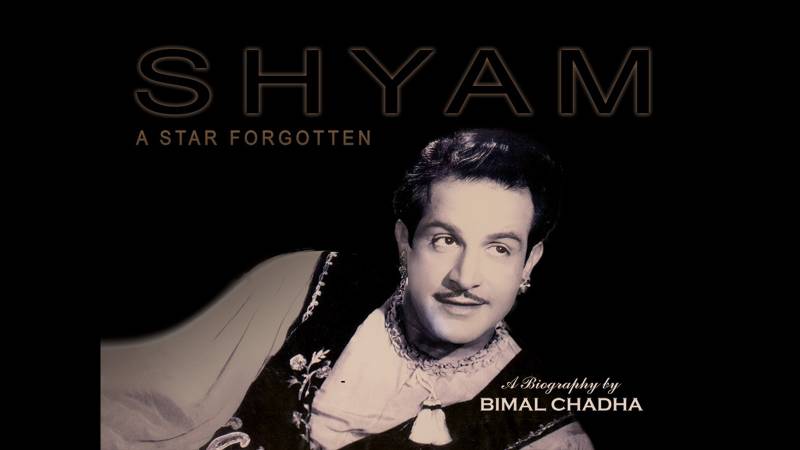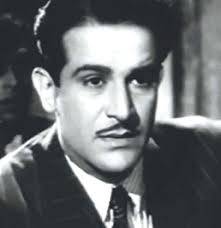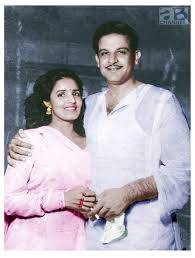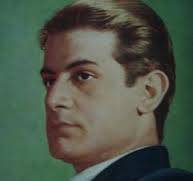
The book under review is a biography of actor Shyam (born Sialkot 20 February 1920 died Bombay 25 April 1951) who died when he was shooting for the film Shabistan (1951). He had almost finished riding the horse during shooting when the stirrup broke, he lost balance and fell off the horse. He received fatal head injuries and died. He was only 31.
Shyam was an enlightened, broadminded individual who read a lot of English and Urdu literature. Saadat Hasan Manto was one of his closest friends. Manto used to have Shyam read his short stories for comments before they were published. Among other close friends was actor Om Prakash, who met him in Lahore and helped him make his film debut in a Punjabi film Gawandhi (Neighbour, 1942) in Lahore.
Although Shyam embodied traditional values of respect for elders and conventions, he was simultaneously cosmopolitan and secular-minded, harbouring no communal feelings. Krishan Chander, Rajinder Singh Bedi, Ismat Chughtai and many other writers and intellectuals frequented Shyam’s house which was always open to friends. Music director C Ramchandra, producer-director Ramesh Saigal and veteran actor Moti Lal were also close to Shyam.

It was therefore not surprising that he married Mumtaz Qureshi, better known as Taji who hailed from Multan. Two children were born to them, a daughter, Sahira, later Sahira Kazmi who became a famous Pakistan Television personality and a son, Shekhar (later named Shakir), who was born posthumously two months after Shyam’s death.
The story of Shyam has been written primarily by his nephew Bimal Chadha (born Rawalpindi 21 February 1946 died New Delhi 3 February 2022), son of Shyam’s younger brother Harbans ji. Bimal had been researching on it for years and wanted to publish it in the centenary year 2020 of Shyam’s birth, but the project only expanded and before it could be published, he died after suffering a fatal stroke. His son Akshay, assisted by his mother Veena and sister Monica completed the manuscript, which has then been edited with proverbial sensitivity and efficacy by the well-known writer on films and music, Manek Premchand.
One of my earliest memories, a faint one as if hearing an echo in an unending tunnel, was that Shyam, the handsomest of all Indian actors had died in faraway Bombay. Traumatic events, I know too well, leave an indelible impact no matter even on very young children.

At home and on Temple Road, Mozangm, where we lived Shyam’s death was mourned as if a family member had died. The Partition had taken place only 4 years earlier; it had not yet sunk into the minds of people that India and Pakistan were two separate, alien, hostile states. I later learnt that Shyam died in 1951, when I was only four.
The only apparent reason Shyam’s children did not want to identify themselves with their Hindu father and close relatives in India must be the religious factor
I got connected to Bimal’s project when I published in Lahore’s Daily Times on 23 June 2012 an op-ed, Actor Shyam Who Died Young. It caught attention widely and I received several emails from people who admired him or who knew him. Bimal read it in Delhi and contacted me. He sought my help in getting in touch with Sahira and Shakir, but they did not respond. I even found Shakir’s email address who I learnt was a psychiatrist working in the UK and pleaded with him to get in touch with Bimal. I received no reply from him.
Harbans ji’s younger brother Chan met Shakir in London several times but could not persuade him to get in touch with his Hindu relatives who wanted him and Sahira to claim the properties their father had left in their name in India.
In 2013, I visited Delhi and met Harbans ji, Bimal and family and stayed a night with them. It was published in the Daily Times as ‘An Evening with Actor Shyam’s Family’’ on 3 November 2013. These details are included in the biography.

The only apparent reason Shyam’s children did not want to identify themselves with their Hindu father and close relatives in India must be the religious factor. Even when news of Bimal’s death was communicated to Sahira and Shakir no words of condolences were received! In Jinnah’s Pakistan, antecedents traced to a Hindu parent and relatives can be the basis of social and political disapproval rendering the famous English saying that ‘blood is thicker than water’ hollow!
Notwithstanding such a cold and unfriendly attitude from them, in the book Taji and her children are presented in the most loving and sympathetic manner. Shyam loved his family and there are several pictures of Sahira in her father’s arms.

The friendship between Shyam and Saadat Hasan Manto is highlighted throughout the book and the conspiratorial rumour that Manto left India because he feared that even Shyam had turned hostile to him because of the communal virus of Partition is demolished and dispelled with credible evidence. The best proof is the support Manto’s daughter Nuzhat has provided to the book about the abiding friendship which existed between them till the end. Her article ‘With Love to Shyam: An Anthem of Solidarity’ speaks volumes. Manto wrote a most moving obituary on Shyam’s death. That written by Krishan Chander also moved readers to tears. His funeral was attended by thousands of friends and fans.
Besides Bimal, Harbans ji (now deceased), Vijay, Akshay, Monica and many others have contributed to the book reminiscing their memory or idea of Shyam. Shyam’s brief but meteoric career (1942 – 51) as tinsel town Bombay’s most sought-after leading star, the struggles and temptations and their impact it had on his relations with Taji are presented with exemplary honesty. Shyam had his fling with his female co-stars but loved his family intensely. That trait can be identified in men universally. Rare black and white photos on glossy paper generate nostalgia and sadness.
I received an invitation in January this year from Akshay to the book launch ceremony on 24th February 2024. My 77th birthday was also on 24 February but there was no chance I would get a visa so quickly, and even if I did, it clashed with a conference in Tamil Nadu. As luck would have it, the visa came through and the Tamil Nadu invitation fell through and almost miraculously Meliha and I could take part in a grand reception for 200 or more people. A chocolate cake was especially cut for me (Akshay knew my love of chocolate). Such are the incidents in life which make one wonder how the world goes round and round.
Shyam’s famous films were Gowandhi (1942), Mun ki Jeet (1944), Majboor (1948), Bazaar (1949), Chandni Raat (1949), Dillagi (1949), Patanga (1949), Raat Ki Rani (1949), Meena Bazaar (1950), Samadhi (1950), Sangeeta (1950) and Shabistan (1951).
I have never come across a book which brings forth so many facets and dimensions in the personality of an individual by contextualising it in the larger setting of the partition of India and the havoc it wreaked on ordinary, decent people uprooted from their roots, forced to cross the border between India and Pakistan where they had to start again from a scratch. Shyam’s biography is a masterpiece.

